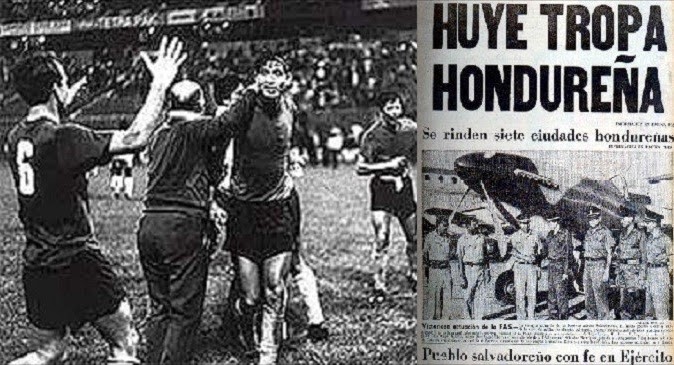
The 1969 play-off match between El Salvador and Honduras (two teams that are not only neighbors but rivals) was filled with anticipation and aggression. This playoff match would decide which nation would be attending the world cup, and which would be staying home. El Salvador and Honduras had each won one match which forced a third, and final, play-off match.1 In the prior matches, fights had broken out between fans in the street and in the stands during the game. But on the day of the final play-off, a much more significant event would take place. The game was scheduled in Mexico City: a third-party country with no bias toward either team. The day of the playoff, El Salvador dissolved all diplomatic ties with Honduras right before the match.
In the first game between the two nations, Honduras won the match 1-0 in its own capital. Some Hondurans stayed outside of the hotel that the El Salvador team had been staying at and threw rocks, set off car alarms and threw firecrackers.2 The 2nd match took place in San Salvador, where the home fans would watch their team win by a commanding score of 3-0. Before the 2nd match took place, the Honduran National team had a security force with them at all times. During the game the security at the stadium was extremely tight with lots of alcohol and weapons confiscated as a security precaution. As the Honduran national anthem played, the home team and fans were extremely disrespectful towards the players and their country. This caused some whiplash for El Salvadorians living in Honduras as their businesses were boycotted and vandalized.3 Leading up to the series of matches, the two nations were in a deep dispute over land reform and immigration. El Salvador was sending its poorest citizens into Honduras so the wealthy could maintain their land.4 El Salvador had a much bigger population than Honduras. Honduras had a population of about 2 million, where as El Salvador had a population of almost 4 million.5

However, they had a significantly smaller amount of land which forced more than 275,000 El Salvadorians to flee into Honduras, causing poverty and crime.6 Honduras accused the El Salvadorians of stealing jobs from the native people of Honduras. But after the 2nd games violence, El Salvador accused Honduras of staying silent while El Salvadorians living in Honduras were raped, murdered, robbed, and oppressed. Neither side was willing to negotiate to the smallest extent, which led to tensions building up even more. In the final match between the two teams, El Salvador won the game in overtime with the score of three to two.7 This caused numerous Salvadorians to be killed in Honduras.8
On July 14th, 1969, almost 3 weeks after the final playoff game, El Salvador bombed targets inside of Honduras. They crippled Honduras by attacking their main airport which left them unable to react to the attack at optimal speed.9 El Salvador then attacked from the ground by marching through the two main roads that connect the countries. Only one day later, the El Salvadorian army had pushed Honduras back over 8 kilometers. The El Salvadorian Army continued to make steady progress. They were nearing the capital city of Honduras, Tegucigalpa, when Honduras finally pushed back. The Honduran Air Force attacked Llopango base. The bombers eventually progressed to Acajutla port, which was important because it was home to El Salvadorian oil refineries. Later that evening huge smoke clouds covered the coast as the the oil refineries were bombed.10
Fearing that the nearing El Salvadorian army would overtake the capital, Honduras called the Organization of American States for help. The Organization of American States (OAS) had an urgent meeting on the evening of July 15th and called for El Salvador to withdraw its troops from Honduras ensuring that its people living in Honduras would not be harmed.11 El Salvador refused, demanding reparations be paid to them and their citizens. El Salvador attempted to further the attack the capital city, but they were unable to proceed with the attack. The previous strike on their oil refineries had destroyed their line of fuels and supplies and they no longer had supplies arriving every other day. Somoza Debayle, the dictator of Nicaragua was also helping Hondurans by arming them with weapons and providing ammunition. The OAS worked night and day in order to provide a cease-fire that would please both parties. Finally, on the night of July 18th, a ceasefire was arranged and became effective two days later.12
Although the cease-fire had been called, El Salvador refused to leave Honduras. They stayed until they were threatened by the OAS with economic sanctions against them. The El Salvador government finally withdrew troops on August 2, 1969. The aftermath of the 100-hour war was anything but slim. More than 2000 civilians were killed, with more than 100,000 immigrants displaced.13 Although they were no longer at war with each other, these two nations peace treaty only came into force on December 10, 1980.14
- Paul Joseph, The SAGE Encyclopedia of War: Social Science Perspectives, 2017 s.v . “Soccer War.” ↵
- Hatcher Graham, Salem Press Encyclopedia, 2013, s.v “Soccer War.” ↵
- Steve C. Ropp, 1982, “The War of the Dispossessed: Honduras and El Salvador, 1969. Thomas P. Anderson.” The Hispanic American Historical Review, no. 2: 296. JSTOR Journals, EBSCOhost (accessed February 5, 2018). ↵
- Richter, Ernesto, John Beverly, Bob Dash, and Irma Fernandez Dash. “Social Classes, Accumulation, and the Crisis of “Overpopulation” in El Salvador” Latin American Perspectives, 7, 1980 ↵
- Ernesto Richter, John Beverly, Bob Dash, and Irma Fernandez Dash. “Social Classes, Accumulation, and the Crisis of “Overpopulation” in El Salvador”, Latin American Perspectives, 7, 1980. ↵
- Charles Clements, Witness to War: an American Doctor in El Salvador (New York; Bantam Book, 1984). ↵
- Hatcher Graham, Salem Press Encyclopedia, 2013, s.v “Soccer War.” ↵
- Charles Clements, Witness to War: an American Doctor in El Salvador (New York; Bantam Book, 1984). ↵
- Charles Clements, Witness to War: an American Doctor in El Salvador (New York; Bantam Book, 1984). ↵
- Charles Clements, Witness to War: an American Doctor in El Salvador (New York; Bantam Book, 1984). ↵
- Charles Clements, Witness to War: an American Doctor in El Salvador (New York; Bantam Book, 1984). ↵
- Charles Clements, Witness to War: an American Doctor in El Salvador (New York; Bantam Book, 1984). ↵
- Charles, Clements, Witness to War: an American Doctor in El Salvador (New York; Bantam Book, 1984). ↵
- Charles Clements, Witness to War: an American Doctor in El Salvador (New York; Bantam Book, 1984); and United Nations -Treaties Series, General Peace Treaty Between the Republics of El Salvador and Honduras, 1980, https://peacemaker.un.org/sites/peacemaker.un.org/files/HN-SV_801030_GeneralTreatyOfPeaceElSalvadorHonduras.pdf. ↵



106 comments
Belia Camarena
It is hard to believe that a war could ensue from a soccer match. Although these nations had serious issues between them, the citizens of both nations were very immature in their actions. Instead of finding a way to peacefully resolve their issues, they resorted to vandalism, murder and then war. This was a really intriguing article, and the author did a great job writing it!
Robert Rodriguez
This was a very good article, It kept me interested the whole time which is new to me because I’m not the biggest fan of soccer. This article gave a good description of the rivalry between the two teams and their fans, to the extent of strategically putting bombs in the rivals country. This has to be one of the craziest team rivalries I’ve ever read about in sports history. its crazy how the out come of a game costed people their lives, thats just mind boggling to me.
Rafael López-Rodírguez
This article proves that soccer in Latin America is taken very seriously! I understand the passion the fans have for the game because I experienced the same atmosphere back home with fans acting all crazy and wild. When it comes to international play I get the bad blood some countries have because of previous rivalries and that is what makes the game even better to watch. Who does not like a good rivalry game? But after reading this article the things people did was very extreme and unnecessary over a soccer game.
Maria Esquivel
This was intense! Coming from a family who loves soccer, and sometimes dislikes any team who defeats our team, I know that feeling of competitiveness. However, to go as far as bombing, hurting and killing others is insane. I was not expecting to read how both Honduras and El Salvador basically went to war over a soccer game. Overall, this article was interesting from start to finish; I applaud the writer for writing a wonderful article.
Timothy ODekirk
I have read this article previously and am glad to be able to read about it again. The extensive rivalry between Honduras and El Salvador must of been huge during the time, especially since the border of the two countries were literary miles from each other, depicting the closeness between the two countries. I mean, the baseball rivalries between the St. Louis Cardinals and the Chicago Cubs are huge itself, and those cities are hours away fro each other. This article was indeed an interesting article and was well worth the second read through.
Noah Laing
This article does a good job describing the tension and competitiveness between El Salvador and Honduras and how impactful a game can be to not only fans, but nations as well. It’s amazing to see that a soccer game could spark feelings so deep that people would put other people of the opposing teams nation in danger, reaching levels of strategically bombing areas, like airports, so that they could oppose significant damage on the nations people. This story certainly made for a interesting article.
Thomas Fraire
This article demonstrates that soccer in Latin America is considered important! I comprehend the energy the fans have for the amusement since I encountered a similar climate back home with fans acting all insane and wild. With regards to global play I get the ill will a few nations have on account of past contentions and that is the thing that improves the diversion even to watch. Who dislikes a decent contention diversion? Be that as it may, in the wake of perusing this article the things individuals did was exceptionally extraordinary and superfluous over a soccer match.
Reese Lujan
I’m really into sports but have never heard of this story. The fact that their competitiveness leads them to violence is quite sad. It was to the point that they even endangered the people that lived in their nations because of things such as bomb threats. The author did such a good job at explaining how the violence didn’t just affect the people that were on the soccer team but the people that lived there too.
Hector Garcia
One word that could describe this article would be unbelievable. I can genuinely get it into my mind that two Central American countries began a war because of soccer. I was left speechless by how far people are able to take silly matters into violence. This article might be the best on this website, mainly because of its unique and interesting topic.
Vanessa Tombo
This article was extremely informative and educational. Prior to reading this article I did not know how El Salvador and Honduras (neighboring countries in Latin America) participated in the 1969 playoffs which would determine which country was to play in the world cup. Though I know very little about sports. I know that soccer is the football equivalence in Latin American countries (and African). Playing in the world cup means having a chance to play some of the best teams worldwide and bringing home the trophy with pride. I was not surprised at how violence quickly erupted after the loss. The article is by far one of my favorite. Great job Suvesh Vasal!